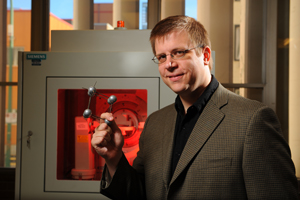Feature story in the Winnipeg Free Press
WINNIPEG, MB – University of Winnipeg Chemistry Professor Chris Wiebe has made a major discovery in the new field of “magnetricity” with an international team of scientists. The discovery is now featured in the prestigious Nature Communications journal on-line.
The team of discoverers, which includes UWinnipeg former student Harlyn Silverstein, Dr. Haidong Zhou (National High Magnetic Field Laboratory, Florida, USA), Dr. Jason Gardner (NIST Centre for Neutron Research, and Indiana University, USA) and Prof. Steve Bramwell (University College London, U.K.), has been investigating a new group of materials known as “spin ices” for the past decade. These are unusual magnetic materials which have properties similar to common “water ice” in the sense that they freeze in a similar way. In “spin ices”, the magnetic spins freeze, and in “water ices”, the water molecules freeze into place. Spin ices have been identified as candidates for a new form of magnetism known as magnetricity – the magnetic charges flow like an electric charge flows in conductors. The new discovery by Wiebe’s team centers on the synthesis of new spin ices ((Ho2Ge2O7 and Dy2Ge2O7) that show very strong “magnetric” effects and represent a whole new arena for testing these ideas in electricity and magnetism.
“This discovery was only made possible through an interdisciplinary approach that was instilled in me at an early point in my career when I was a student at The University of Winnipeg,” said Wiebe, an alumnus of the class of 1996. “I am very pleased that I had the opportunity to involve students in research that has produced such significant results.”
Harlyn Silverstein, a former Gold Medal winner at UWinnipeg and now a graduate student at the University of Manitoba, completed this work as an undergraduate in the Department of Chemistry at UWinnipeg.
Wiebe recently returned to UWinnipeg to establish a world-class materials research facility known as PRIME (The Prairie Research Institute for Materials and Energy). This new centre, to be established in the Richardson College for the Environment and Science Complex, is backed by $1 million in recent Canadian Foundation for Innovation funding for a state-of- the-art materials laboratory.
The new spin ices highlighted in the article have also been tested as candidates for “magnetic monopoles” – isolated poles of magnetism that are exceedingly rare in nature.
Over the last decade, there has been mounting evidence that monopoles exist inside spin ices, and Wiebe’s recent work shows evidence for a very dense gas of monopoles forming at low temperatures. The existence of magnetic monopoles, which are strictly forbidden according to the laws of physics, would represent a paradigm shift that would change how we think about electromagnetism.
Nature Communications is an online-only, multidisciplinary journal dedicated to publishing high-quality research in all areas of the biological, physical and chemical sciences. Papers published by the journal represent important advances of significance to specialists within each field.
MEDIA CONTACT
Diane Poulin, Communications Officer, The University of Winnipeg
P: 204.988.7135, E: d.poulin@uwinnipeg.ca





